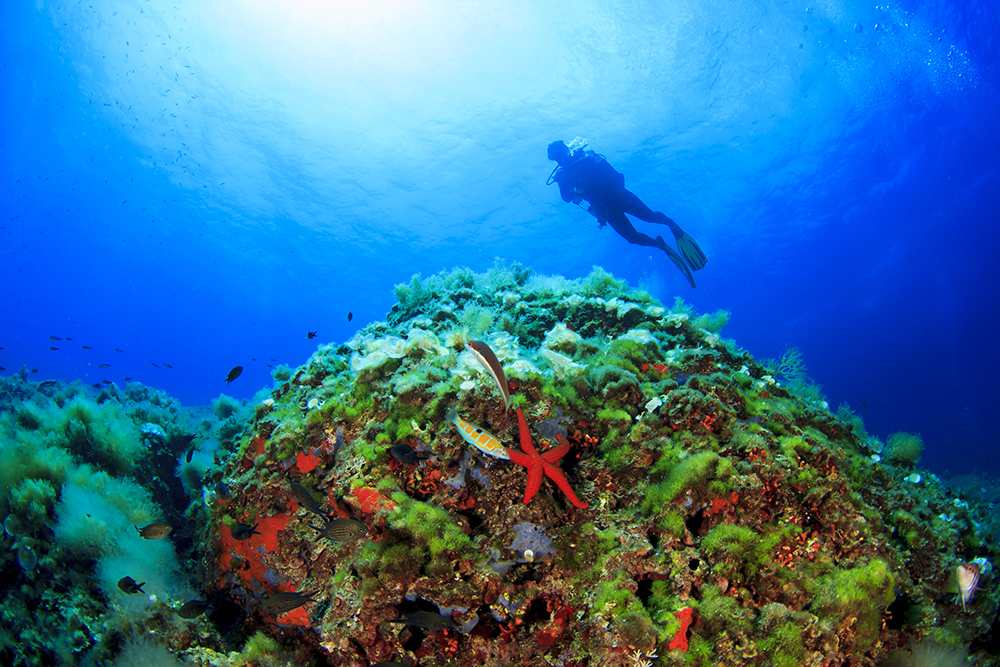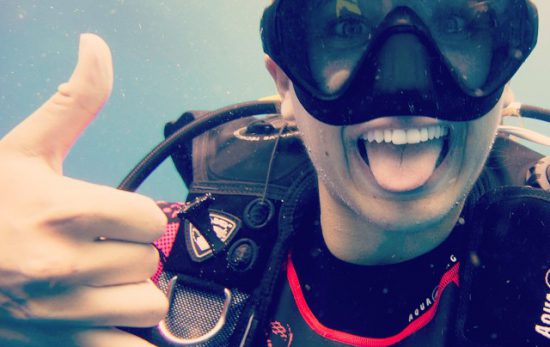East of the Spanish mainland, the Balearic Islands are a treasure to behold. They benefit from a lush Mediterranean climate that is conducive to year round diving – although prime time is between July and September. Comprised of four main islands with surrounding smaller isles, there are over 80 dive sites to choose from.
There’s plenty to check out topside too, think bohemian vibes, rustic old towns, stunning beaches, inlets and coves, plus enticing mountain ranges with great hiking opportunities. Each of the islands has a unique character that promises to inspire all types of travellers.

Mallorca –
The largest of the main islands, Mallorca, provides easy access to the Marine Reserve of Cala Ratjada. The reserve is 11,000 hectares of rugged rocky formations that bear the name the ‘big cheese’ due to the proliferation of holes within the structure. Much like Swiss cheese – as the namesake suggests – it is possible to see straight through these port hole like tunnels, making this the perfect environment for a wide range of sea life including moray eels, cuttlefish and the curious dolphin-fish.
The Cove de Jeroni is also a must experience to tick off too. One of the more unusual dives you can complete, the real highlight is surfacing within a cavern to an astonishing light show. Streams of reflected light bounce around the cave highlighting the stalactites clinging to the ceiling.
Menorca –
Decreed a UNESCO Biosphere Reserve, Menorca is a without question a wonder of natural beauty. Hence, it’s no wonder that this extends below the surface to the countless walls and underwater caves that can be found along the limestone coast. Discover a 220 metre long cave with air pockets that lets you glimpse a superb array of stalactites and stalagmites. The incredible water quality and huge range of biodiversity that can be found around the island is something that you won’t want to miss. See John Dory, rays, groupers and more.
Ibiza –
Ibiza is home to the largest shipwreck in the Mediterranean, the Don Pedro. At a whopping 142 metres in length and lying at a maximum depth of 46 metres, you’ll need the minimum of PADI Advanced Open Water Certification to reach this particular vessel. However, there are plenty of other shipwrecks to uncover and numerous options for those looking to get certified. Behold a forest of Gorgonians, or find yourself drifting around ‘The Haystack’ as you’re watched by shoals of barracuda and damsel fish. The crystal clear waters ensure that you’ll see for miles and be amazed by the geology.

Formentera –
The more secluded and quite of the islands, Formentera’s peaceful and relaxed topside is reflective of the magically serene dive scene. The underwater landscape is dotted with colourful anemones, sea grass meadows and various rock formations. The waters attract a vast range of protected marine life including hammerheads, blue sharks and seahorses plus vibrant starfish, playful dolphins and sea turtles.
Convinced that you need to discover the underbelly to the Balearic Islands? The PADI Scuba Diver course is the perfect companion to your Spanish islands adventure. As a subset of the PADI Open Water course, the PADI Scuba Diver will provide you with the basics of scuba diving and the freedom to explore to 12m in depth under the guidance of a PADI Professional. Great if you’re short on time and can’t complete the full Open Water course.
Get started online before you go with PADI eLearning. You’ll only need to complete the first three of five sections to qualify for the PADI Scuba Diver knowledge component.
Start now or contact a PADI Dive Shop in the Balearic Islands.
Mallorca
[unordered_list style=”star”]
- Aqua Sub Mallorca Private Dive
- Aventura IB
- Oceanides Aquaventura SL
- Diving Big Blue SL
- ZOEA Mallorca
- Acqua Life Dive Center SL
- Octopus
- Adventure Sports Skualo
- Diving Dragonera
- BalearDivers
- Delphinus Mallorca
- Albatros Diving
- Scuba Mallorca
Menorca
[unordered_list style=”star”] [/unordered_list]Ibiza
[unordered_list style=”star”] [/unordered_list]

